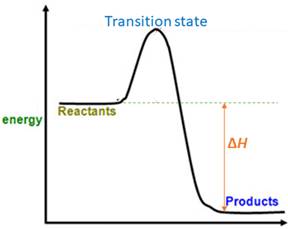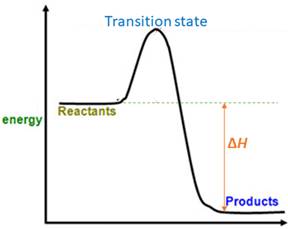
Concept explainers
(a)
Interpretation:
Whether reactants or products are favored at equilibrium and equilibrium constant value
Concept introduction:
For a reversible reaction, equilibrium constant (

When energy is absorbed, the reaction is endothermic and the value of
Similarly, when energy is released, the reaction is exothermic and
Answer to Problem 48P
Reactants are favored.
Explanation of Solution
The magnitude of
Accordingly,
Therefore, reactants are favored at the equilibrium.
(b)
Interpretation:
Whether reactants or products are favored at equilibrium and change in enthalpy
Concept introduction:
For a reversible reaction, equilibrium constant (

When energy is absorbed, the reaction is endothermic and the value of
Similarly, when energy is released, the reaction is exothermic and
Answer to Problem 48P
Reactants are favored.
Explanation of Solution
The value of
(c)
Interpretation:
Whether reactants or products are favored at equilibrium and equilibrium constant value 10,000 needs to be determined.
Concept introduction:
For a reversible reaction, equilibrium constant (

When energy is absorbed, the reaction is endothermic and the value of
Similarly, when energy is released, the reaction is exothermic and
Answer to Problem 48P
Products are favored.
Explanation of Solution
The magnitude of
Accordingly,
Therefore, products are favored at equilibrium.
(d)
Interpretation:
Whether reactants or products are favored at equilibrium and change in enthalpy
Concept introduction:
For a reversible reaction, equilibrium constant (

When energy is absorbed, the reaction is endothermic and the value of
Similarly, when energy is released, the reaction is exothermic and
Answer to Problem 48P
Products are favored.
Explanation of Solution
The value of
Want to see more full solutions like this?
Chapter 6 Solutions
GENERAL ORGANIC & BIOCHEMISTRY >ACCESS<
- Hydrogen for use in ammonia production is produced by the reaction CH4(g)+H2O(g)750oCNicatalystCO(g)+3H2(g) What will happen to a reaction mixture at equilibrium if a. H2O(g) is removed? b. the temperature is increased (the reaction is endothermic)? c. an inert gas is added to a rigid reaction container? d. CO(g) is removed? e. the volume of the container is tripled?arrow_forward. What is the effect on the equilibrium position if an exothermic reaction is carried out at a higher temperature? Does the net amount of product increase or decrease? Does the value of the equilibrium constant change if the temperature is increased? If so, how does it change’?arrow_forwardCharacterize each of the following as product- or reactant-favored at equilibrium. (a) CO(g) + O2(g) CO2(g)Kp = 1.2 1045 (b) H2O(g) H2(g) + O2(g)Kp = 9.1 1041 (c) CO(g) + Cl2(g) COCl2(g)Kp = 9.1 1011arrow_forward
- Ammonia is a weak base that reacts with water according to this equation: NH3(aq)+H2O(l)NH4+(aq)+OH(aq) Will any of the following increase the percent of ammonia that is converted to the ammonium ion in water? (a) Addition of NaOH (b) Addition of HCI (c) Addition of NH4CIarrow_forwardBased on the diagrams, chemical reaction, and reaction conditions depicted in Problem 9-83, which of the diagrams represents the equilibrium mixture if the numerical value of the equilibrium constant is 9.0?arrow_forward. Consider the reaction 2CO(g)+O2(g)2CO2(g)Suppose the system is already at equilibrium, and then an additional mole of CO 2(g) is injected into the system at constant temperature. Does the amount of O2(g) in the system increase or decrease? Does the value of K for the reaction change?arrow_forward
- The only stress (change) that also changes the value of K is a change in temperature. For an exothermic reaction, how does the equilibrium position change as temperature increases, and what happens to the value of K? Answer the same questions for an endothermic reaction. If the value of K increases with a decrease in temperature, is the reaction exothermic or endothermic? Explain.arrow_forwardDissolving CaCO3 is an endothermic reaction. The following five graphs represent an experiment done on CaCO3. Match the experiment to the graph. (a) HCl is added. (b) The temperature is increased. (c) CaCl2 is added. (d) NaCl is added.arrow_forwardConsider the reaction 2N2O(g) + O2(g) 4NO(g) Suppose the system is at equilibrium, and then an additional mole of N2O(g) is injected into the system at constant temperature. Once the reaction reestablishes equilibrium, has the amount of N2O increased or decreased from its original equilibrium amount? Explain. What happens to the value of the equilibrium constant with this change?arrow_forward
- If a reaction is reversible, when can it be said to have reached equilibrium?arrow_forwardWhen writing an equation, how is a reversible reaction distinguished from a nonreversible reaction?arrow_forwardFor the generalized chemical reaction A(g)+B(g)C(g)+D(g) determine whether the concentration of D in an equilibrium mixture will (1) increase, (2) decrease, or (3) not change when each of the following changes is effected. a. concentration of A is increased b. concentration of B is decreased c. concentration of C is increased d. concentration of C is decreasedarrow_forward
 Chemistry & Chemical ReactivityChemistryISBN:9781133949640Author:John C. Kotz, Paul M. Treichel, John Townsend, David TreichelPublisher:Cengage Learning
Chemistry & Chemical ReactivityChemistryISBN:9781133949640Author:John C. Kotz, Paul M. Treichel, John Townsend, David TreichelPublisher:Cengage Learning Chemistry & Chemical ReactivityChemistryISBN:9781337399074Author:John C. Kotz, Paul M. Treichel, John Townsend, David TreichelPublisher:Cengage LearningChemistry: Matter and ChangeChemistryISBN:9780078746376Author:Dinah Zike, Laurel Dingrando, Nicholas Hainen, Cheryl WistromPublisher:Glencoe/McGraw-Hill School Pub Co
Chemistry & Chemical ReactivityChemistryISBN:9781337399074Author:John C. Kotz, Paul M. Treichel, John Townsend, David TreichelPublisher:Cengage LearningChemistry: Matter and ChangeChemistryISBN:9780078746376Author:Dinah Zike, Laurel Dingrando, Nicholas Hainen, Cheryl WistromPublisher:Glencoe/McGraw-Hill School Pub Co Introductory Chemistry: A FoundationChemistryISBN:9781337399425Author:Steven S. Zumdahl, Donald J. DeCostePublisher:Cengage Learning
Introductory Chemistry: A FoundationChemistryISBN:9781337399425Author:Steven S. Zumdahl, Donald J. DeCostePublisher:Cengage Learning General, Organic, and Biological ChemistryChemistryISBN:9781285853918Author:H. Stephen StokerPublisher:Cengage Learning
General, Organic, and Biological ChemistryChemistryISBN:9781285853918Author:H. Stephen StokerPublisher:Cengage Learning





